Subscribe to our ▶️ YouTube channel 🔴 for the latest videos, updates, and tips.
Three-Dimensional Figures
Three-dimensional figures are discussed here with the figures or pictures along with the explanation.
Solids:
Objects having fixed shape and size, and occupying fixed space are called solids.
Solids occur in various geometrical shapes. These shapes are known three-dimensional figures.
Some 3-D shapes are namely cuboids, cubes, cylinders and cones.
We will discuss about some of the 3-dimensional figures having flat faces, namely cubes, cuboids, prisms, pyramids and tetrahedrons.
Faces, Vertices and Edges of a 3-dimensional Figure:
(i) Faces: Each flat part of a solid is called its face.
(ii) Vertices: Each corner where three faces of a solid meet is called its vertex. The plural of vertex is vertices.
(iii) Edges: The two faces of a solid meet in a line, called an edge.
Now, we shall discuss about the faces, vertices and edges of some 3-dimensional figures having flat faces.
I. Cuboid:
A solid bounded by six rectangular plane faces is called a cuboid.
A box, a matchbox, a book, a brick, a tile, etc., are all in the shape of a cuboid.
In the adjoining figure, ABCDEFGH is a cuboid.
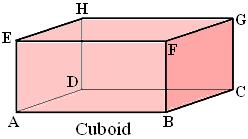
(i) Faces of a Cuboid:
A cuboid has 6 faces.
In the given figure, the 6 faces of the cuboid are:
ABCD, EFGH, ADHE, BCGF, ABFE and DCGH.
(ii) Vertices of a Cuboid:
A cuboid has 8 vertices.
In the given figure, the 8 vertices of the cuboid are:
A, B, C, D, E, F, G, H.
(iii) Edges of a Cuboid:
A cuboid has 12 edges.
In the given figure, the 12 edges of the cuboid are:
AB, BC, CD, DA, EF, FG, GH, HE, AE, DH, BF, CG.
II. Cube:
A cuboid whose length, breadth and height are equal is called a cube.
Dice, sugar cubes, ice cubes, etc., are all examples of a cube.
In the adjoining figure, ABCDEFGH is a cube.
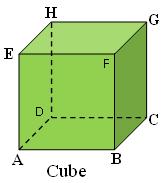
(i) Faces of a Cube:
A cube has 6 faces.
In the given figure, the 6 faces of the cube are:
ABCD, EFGH, ADHE, BCGF, ABFE and DCGH.
(ii) Vertices of a Cube:
A cube has 8 vertices.
In the given figure, the 8 vertices of the cube are:
A, B, C, D, E, F, G, H.
(iii) Edges of a Cube:
A cube has 12 edges.
In the given figure, the 12 edges of the cube are:
AB, BC, CD, DA, EF, FG, GH, HE, AE, DH, BF, CG.
Note:
Here, in three-dimensional figures we will discuss about right prism arid regular pyramid.
III. PRISM:
A solid whose two faces are parallel plane polygons and the side faces are rectangles is called a prism.
Triangular Prism:
A triangular prism is made up of two parallel end-faces each one of which is a triangle and three lateral faces each one of which is a rectangle.
In the adjoining figure, ABCDEF is a triangular prism.
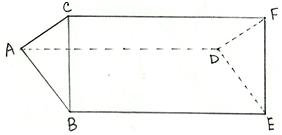
(i) Faces of a Triangular Prism:
A triangular prism has 2 triangular faces and 3 rectangular faces.
In the given figure,
2 triangular faces are ∆ABC and ∆DEF,
3 rectangular faces are ABED, ADFC and CBEF.
(ii) Vertices of a Triangular Prism:
A triangular prism has 6 vertices.
In the given figure, the 6 vertices of the triangular prism are A, B, C, D, E, F.
(iii) Edges of a Triangular Prism:
A triangular prism has 9 edges.
In the given figure, the 9 edges of the triangular prism are:
AB, BC, CA, DE, EF, FD, AD, BE, CF
Note:
A cuboid is also called a rectangular prism.
IV. PYRAMID:
A pyramid is a solid whose base is a plane rectilinear figure whose side faces are triangles having a common vertex, called the vertex of the pyramid.
(a) Square Pyramid:
It is a solid whose base is a square and whose side faces are triangles having a common vertex.
In the adjoining figure, OABCD is a square pyramid with its vertex at O.
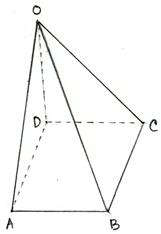
(i) Vertices of a Square Pyramid:
A square pyramid has 5 vertices.
In the given figure, OABCD is a square pyramid having O, A, B, C, D as its vertices.
(ii) Faces of a Square Pyramid:
A square pyramid has faces one of which is a square face and the rest four are triangular faces.
In the given figure, OABCD is a square pyramid having ABCD as its square face and OAD, OCD, OBC and OAB as its triangular faces.
(iii) Edges of a Square Pyramid:
A square pyramid has 8 edges.
In the given figure, the square pyramid OABCD has 8 edges, namely, AB, BC, CD, DA, OA, OB, OC and OD.
(b) Rectangular Pyramid:
It is a solid whose base is a rectangle and whose side faces are triangles having a common vertex.
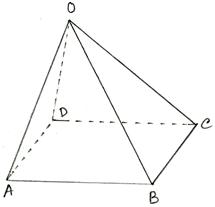
In the adjoining figure, OABCD is a rectangular pyramid.
(i) It has 5 vertices, namely O, A, B, C, D.
(ii) It has 1 rectangular face, namely ABCD, and 4 triangular faces, namely OAD, ODC, OAB, OBC
(iii) It has 8 edges, namely AB, BC, CD, DA, OA, OB, DC, OD
(c) Triangular Pyramid (Tetrahedron):
It is a solid whose base is a triangle and whose side faces are triangles having a common vertex.
In the adjoining figure, OABC is a triangular pyramid.
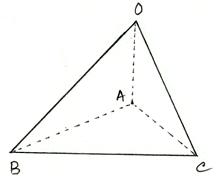
(i) It has 4 vertices, namely O, A, B, C.
(ii) It has 4 triangular faces, namely ABC, OAB, OAC and OBC.
(iii) It has 6 edges, namely OA, OB, OC, AB, AC, BC.
● Three-Dimensional Figures
● Three-Dimensional Figures - Worksheets
Worksheet on Three Dimensional Figures
8th Grade Math Practice
From Three-Dimensional Figures to HOME PAGE
Didn't find what you were looking for? Or want to know more information about Math Only Math. Use this Google Search to find what you need.


New! Comments
Have your say about what you just read! Leave me a comment in the box below. Ask a Question or Answer a Question.